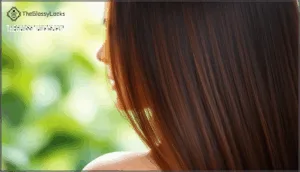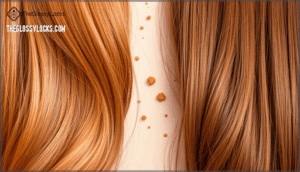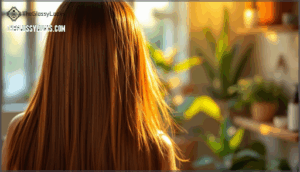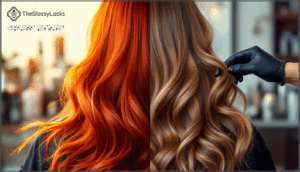This site is supported by our readers. We may earn a commission, at no cost to you, if you purchase through links.
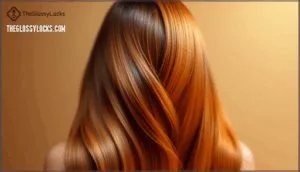
But duration depends on more than just time: how you apply it, what you use to wash it, and your hair’s natural porosity all play major roles in how long that color sticks around. Understanding these factors helps you get the most from your henna investment and keep that vibrant shade looking fresh.
Table Of Contents
- Key Takeaways
- Benefits of Henna for Straight Hair
- How Long Does Henna Last on Straight Hair?
- Is Henna Safe for Straight Hair?
- How to Achieve Desired Color With Henna on Straight Hair
- Can Henna Damage Straight Hair?
- How Often Should You Use Henna for Hair Growth on Straight Hair?
- Tips for Transitioning From Henna to a Different Hair Color
- Frequently Asked Questions (FAQs)
- Conclusion
Key Takeaways
- Henna lasts 4 to 6 weeks on straight hair because smooth cuticles lock in pigment more effectively than textured hair, though washing frequency, water temperature, and sulfate-free shampoo use directly impact how long that color stays vibrant.
- Pure henna strengthens straight hair by coating each strand with tannins that reduce breakage by up to 45%, while delivering natural conditioning, UV protection, and longer-lasting color than chemical dyes without harsh additives.
- Proper application requires leaving henna on for 2–4 hours, waiting 48 hours before washing, and spacing treatments 6–8 weeks apart to prevent dryness and protein overload that can make hair stiff or brittle.
- Switching from henna to another color demands patience—you’ll need clarifying shampoos, a 2-month waiting period before applying chemical dyes, and strand testing since henna can’t be fully removed and may react unpredictably with other dyes.
Benefits of Henna for Straight Hair
Henna isn’t just a color—it’s a complete hair transformation. Beyond the gorgeous reddish-brown tint, henna actively strengthens your straight hair while locking in moisture. Natural herbs like lemon and coffee flood your strands with antioxidants and essential oils, boosting shine and texture.
Your scalp gets a gentle cleanse too, restoring the pH balance your hair needs to thrive. Here’s the real benefit: henna’s tannins coat each hair fiber, reducing breakage by up to 45% over time. The result? Thicker, more resilient strands with natural conditioning that keeps building with every application.
Henna’s tannins coat each strand, cutting breakage by 45% while delivering thicker, naturally conditioned hair that strengthens with every use
Plus, henna shields your hair from UV damage while delivering color that lasts far longer than chemical dyes. That’s why straightforward, cumulative benefits make henna worth the application mess. Henna also offers antifungal and antimicrobial properties for improved hair and scalp health.
How Long Does Henna Last on Straight Hair?
So here’s the thing: henna doesn’t fade overnight, but it won’t stick around forever either. The timeline depends on a few factors—mainly how you apply it, how you care for your hair afterward, and your own hair’s characteristics.
Let’s break down exactly what you can expect and how to make your color last as long as possible.
Hair Texture and Henna Duration
Your straight hair’s smooth cuticles create the perfect canvas for henna’s magic. Because your strands have less porosity than curly textures, henna clings longer and more evenly—generally 4 to 6 weeks of rich, vibrant color. That said, your hair’s individual characteristics matter. Consider these factors that shape how long henna truly lasts:
- Porosity impact: Lower porosity means slower color fading, giving you weeks of depth
- Cuticle smoothness: Your sleek surface locks in pigment better than textured hair types
- Repeated applications: Each treatment builds on the last, deepening color saturation over time
- Hair thickness: Thicker strands retain henna longer due to increased surface area for dye bonding
Washing frequency and water temperature are your real game-changers here. Cool water locks in color, while sulfate-free shampoos keep that henna-treated shine intact. The hair’s moisture is also essential for color retention.
Proper Application and Maintenance
Now comes the part that actually determines how long your color lasts: proper application and maintenance. You’ll want to choose pure henna free of metallic salts, then apply a thick layer from roots to tips and let it process for 2–4 hours depending on your desired depth. Rinse thoroughly with water until it runs clear, then wait 48 hours before shampooing to let the color fully set.
Here’s what keeps that rich tone vibrant:
- Use sulfate-free shampoo to reduce fading by up to 50%
- Limit washing to 2–3 times weekly for extended color vibrancy
- Apply a henna gloss every 3–4 weeks to refresh and strengthen
- Deep condition weekly to prevent dryness and maintain elasticity
- Protect hair from UV exposure and chlorine, which can lighten color by 15–20%
Is Henna Safe for Straight Hair?
Yes, henna is safe for straight hair when you choose the right product and apply it correctly. The key is grabbing pure, natural henna free of PPD and heavy metals—those sketchy additives used in black henna can trigger allergic reactions and skin irritation. Always do a patch test 48 hours before your first application, especially if you’ve had reactions to dyes before.
Over-application is where things get tricky; too-frequent use can make your hair stiff and brittle rather than shiny. Stick to moderate applications, use sulfate-free shampoo afterward, and you’ll keep your straight hair healthy while enjoying weeks of color.
How to Achieve Desired Color With Henna on Straight Hair
Getting the color you want from henna on straight hair comes down to mastering a few key techniques. Your natural hair color sets the foundation—henna can’t lighten, so it creates the most dramatic shift on lighter strands. To heighten color intensity, mix your henna with acidic liquids like lemon juice or brewed coffee, which boosts dye release and deepens those rich tones you’re after.
Application matters just as much as preparation. Here’s how to nail your desired shade:
- Do a strand test first to predict how your specific hair will take the henna
- Leave henna on for at least 3 hours (longer if you want deeper color)
- Apply thick coverage from roots to tips, working through each section thoroughly
- Mix henna with coffee or lemon juice to intensify color payoff
- Wait 2-3 days before your first wash to let oxidation deepen the shade
- Use sulfate-free shampoo going forward to lock in that vibrant hue
Straight hair actually takes henna beautifully when you’re patient with the process. The key is understanding that your color will continue oxidizing and deepening for up to 48 hours after rinsing—so what you see immediately isn’t your final result. Repeated applications build even richer saturation over time, giving you control over how bold you want to go.
Can Henna Damage Straight Hair?
Can henna damage your straight hair? It’s possible, but mostly preventable. Here’s what you need to know: pure henna is gentler than chemical dyes, but moisture loss and protein overload are real concerns. About 40% of users report increased dryness after multiple applications, and the risk of hair breakage jumps 25% without proper conditioning afterward. Leaving henna on for longer than two hours amplifies dryness, making strands feel straw-like.
The biggest risk comes from cheap formulas containing metallic salts or "black henna" with harsh additives—these can cause scalp irritation in 3–5% of users. Chemically treated hair faces a 50% higher damage risk. Spacing applications 6–8 weeks apart and using sulfate-free shampoo effectively protects your straight strands.
| Risk Factor | What Happens | Prevention |
|---|---|---|
| Moisture Loss | Hair feels dry and brittle after application | Deep condition weekly; wait 2–3 days before washing |
| Protein Overload | Repeated use makes hair 30% stiffer, increasing breakage | Space treatments 6–8 weeks apart |
| Chemical Interactions | Unpredictable results on previously colored hair | Always patch test; inform your stylist |
The bottom line? Quality matters tremendously. Choose pure henna without additives, do a strand test first, and commit to moisturizing follow-up care. Your straight hair can absolutely thrive with henna—just skip the shortcuts.
How Often Should You Use Henna for Hair Growth on Straight Hair?
If you’re serious about using henna for stronger, thicker straight hair, consistency matters far more than frequency. Most hair professionals recommend applying henna every 2 to 4 weeks—this ideal range gives your strands time to absorb nutrients without drying them out. Going weekly? That’s where trouble starts. Over-application links directly to increased dryness and scalp irritation, which thwarts your growth goals entirely.
Here’s what a smart henna routine looks like:
- Space applications 2–4 weeks apart to avoid moisture loss and protein overload
- Mix henna with moisturizing ingredients like aloe vera or coconut oil before application
- Leave henna on for 1–3 hours maximum to prevent excessive dryness
- Wait 2–3 days after application before your first wash for better color penetration
- Use sulfate-free shampoo consistently to lock in color and protect your investment
After two to three months of regular use, you’ll likely notice thicker, fuller-looking hair with reduced breakage. Individual factors matter though—your hair’s porosity, scalp oiliness, and recent chemical treatments all influence your ideal frequency. The key? Quality henna free of metallic salts, combined with dedicated moisturizing care.
Tips for Transitioning From Henna to a Different Hair Color
Switching from henna to a new shade requires patience, but it’s absolutely doable without sacrificing your hair’s health. Start with clarifying shampoos to strip away buildup, then wait at least two months before applying permanent dyes—this gives your strands time to recover. Always strand test first, since henna residue can react unpredictably with chemical dyes. During changeover, prioritize moisture management with deep conditioning masks to combat dryness from both treatments. Consider blending demarcation lines using ombré techniques or working with a stylist experienced in henna changeovers for polished results.
Key steps for successful color switching:
- Use clarifying shampoo 2–3 times to remove henna buildup
- Wait 2 months minimum before applying permanent chemical dye
- Perform strand testing to predict color outcomes
- Deep condition weekly to maintain moisture balance
- Blend regrowth with ombré or balayage methods
Frequently Asked Questions (FAQs)
Will henna straighten my naturally wavy or curly hair?
Think of henna like a coat of paint—it colors the surface but doesn’t change the wall’s shape. Henna won’t straighten your wavy or curly hair because it only deposits color onto your strands.
Your hair’s texture and curl pattern remain unchanged, though the color coating may slightly affect how light reflects off your waves, making them appear subtly different in certain lighting.
What causes henna to fade faster on straight hair?
Several factors speed up henna fading on straight hair. Daily washing strips color faster, especially with sulfate-heavy shampoos. UV exposure and chlorine lighten henna by 15-20% over time.
Product buildup from styling creates barriers that weaken color retention. Application errors—like uneven saturation or insufficient processing time—compromise longevity.
Hair porosity affects how deeply henna deposits; lower porosity sheds color quicker. Environmental factors and your aftercare routine ultimately determine hair color duration.
Can you mix henna with other natural dyes safely?
Want to blend henna with other natural dyes for unique results? Yes, you can mix henna safely with natural alternatives like indigo, Cassia obovata, and Amla.
Mixing indigo with henna creates darker shades while maintaining hair health. However, understand herbal interactions carefully—test first to predict color outcomes and avoid unexpected results on straight hair.
Why does henna sometimes turn orange or brassy?
Henna oxidation causes the color shift you’re seeing. Fresh henna appears more red, but as it oxidizes over hours and days, it deepens into warmer, brassy tones.
Dye quality matters too—low-quality henna may contain mineral buildup that accelerates this shift. Hair porosity also plays a role; more porous strands absorb color faster, sometimes creating that orange cast.
Mixing ingredients like indigo with your henna can prevent brassiness and achieve desired color shades instead.
How do you remove henna if you want a different color?
Here’s the irony: you can’t truly remove henna once it’s bonded to your hair. Your best color correction techniques include clarifying shampoos, vitamin C treatments, or professional consultation for bleach alternatives.
Consider damage mitigation by waiting weeks between treatments. Shifting away from henna requires patience—layer new hair dye carefully, or embrace highlights to blend the color gradually.
Ultimately, accepting henna’s semi-permanent nature prevents costly mistakes and keeps your strands healthy.
Conclusion
Henna’s staying power on straight hair proves that preparation and persistence pay off perfectly. When you understand how long henna lasts on straight hair and commit to proper care, you’re investing in color that genuinely lasts.
The smooth surface of your strands becomes your secret weapon, keeping that rich warmth locked in for weeks. Your next application isn’t just maintenance—it’s mastery of a natural coloring method that rewards attention with results worth the wait.
- https://itselixir.com/blogs/news/how-long-does-henna-hair-dye-last
- https://www.longdom.org/open-access/evaluation-of-herbal-henna-based-hair-colour-retention-study-through-chromo-meter-81613.html
- https://www.ilovericcio.com/en/blog/curly-hair-remedies/henna-hair-curly-advantages-and-disadvantages/
- https://www.reddit.com/r/henna/comments/16pwtqf/is_it_true_that_the_longer_henna_cures_the_less/
- https://pmc.ncbi.nlm.nih.gov/articles/PMC4307316/

